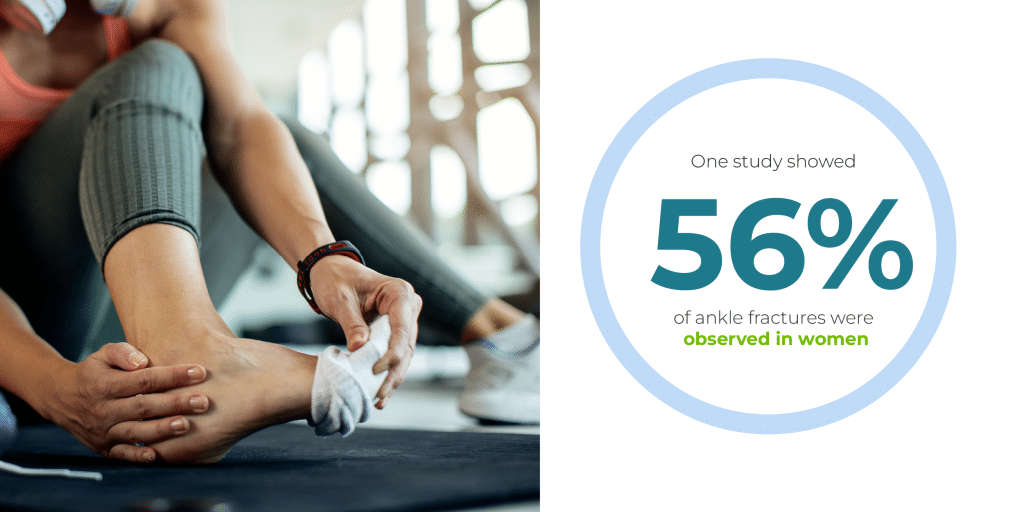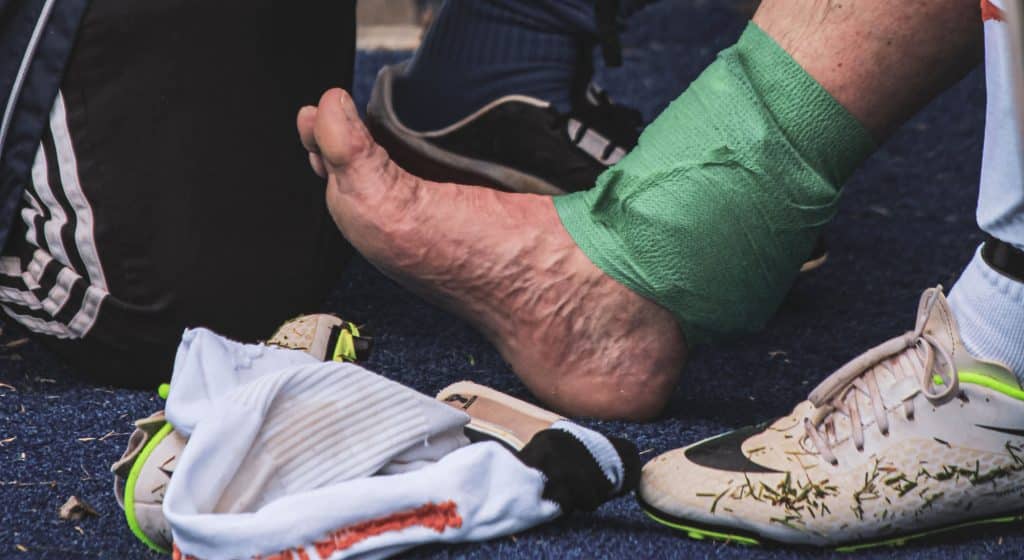The pain shoots up and down, side to side, and you can’t think straight. In the moments immediately following an ankle injury, many people think the same thing, “Oh no, I hope it’s just an ankle sprain!” No one is glad to have pain in their ankle–whether it’s a sprain or a broken ankle (also called a fracture)–but it’s important to know what to do next and how to tell if your injury is a fracture or a sprain.
Maybe you stepped off a patio and landed on the side of your foot, stumbled over an unexpected object, or tripped while playing tennis. No matter how you did it, your ankle hurts! So, how can you tell if it’s a sprained or broken ankle?
What Is an Ankle Sprain?
Ligaments and tendons surround the bones that make up the ankle. The ligaments help the ankle by providing flexible stability so the ankle can move and support your body. When your ligaments are stressed or strained at an angle that is not natural for them and beyond their capabilities to stretch, they can tear, causing a sprained ankle.
What Is an Ankle Fracture?
There are three bones in the ankle. Ligaments and tendons support these bones. The three bones are the tibia, fibula, and talus. In its simplest definition, a broken ankle or ankle fracture is a fracture or crack to one (or more) of the bones. Some may have a tiny hairline crack in one bone, but others may experience fractures in multiple ankle bones.

One study showed that fractures are more common in women than in men. About 56% of the fractures observed were in women, compared to 44% in men. Regardless of gender, ankle fractures are painful and common. Comparing the pain of one fracture to another can be vastly different, which is part of why it is hard to tell if you have sprained your ankle or fractured it.
Signs of Sprains and Fractures
The symptoms of ankle sprains and a broken ankle are similar. People, including medical professionals, often cannot tell with certainty if you have one or the other without taking x-ray scans of your ankle. So while learning the different signs to look for is helpful, the best way to know what’s wrong is to visit your doctor. If you are in Texas, the team at Integrity Urgent Care is equipped to help you. Make an appointment today.
Signs of an Ankle Sprain
- Swelling
- Bruising
- Pain in the soft part of your ankle
- No audible sound when the injury occurred
Signs of an Ankle Fracture
- Swelling
- Bruising
- Pain directly over or near the ankle bones
- Numbness
- Tingling
- An audible crack when the injury occurred
- Oddly misshapen looking
What Should I do After an Ankle Injury?
Should you poke it? Or try to wiggle your ankle around? Try to put all of your weight on it and walk around. No, that’s probably not wise. Also, that would be pretty painful. But you can take some simple steps to help stabilize your ankle before getting medical assistance. Find a nice place to rest, elevate your ankle and apply ice.

If you didn’t hear an audible crack when the injury occurred and you’re trying to determine if it is sprained or broken, take a minute to rest and assess. If the pain persists, you should seek support from a medical professional for your ankle sprain or fracture. If you are experiencing intense pain or suspect a fracture, seek help quickly.
Can I go to urgent care for a broken ankle or ankle sprain?
Ankle injuries are never convenient. Instead of waiting around at an expensive emergency room or waiting for an appointment with a primary care physician, seek help from Integrity Urgent Care. With locations across Texas, our providers are equipped to help diagnose and treat sprains and fractures. Simply check in online now, and we’ll see you soon!
Diagnosing an Ankle Injury
To diagnose your injury, our providers will take a few moments to ask how you injured your ankle and examine your ankle, lower leg and foot. We may ask you to move your ankle and foot around or help identify specific areas of pain or tenderness. Following an initial assessment, we may x-ray your ankle to see if any fractures are present.
How Are Ankle Sprains and Broken Ankles Treated?
After you have met with a medical provider and reached a diagnosis for your injury, you will likely need ongoing treatment or rest to heal from your injury. Most doctors will recommend taking an over-the-counter pain medicine like ibuprofen (Advil) or acetaminophen (Tylenol) for pain management and swelling. In addition, there are specific treatments for sprains and breaks.

Try these things to help your ankle after a sprain:
- Elevate your ankle – elevating your ankle above your heart, especially while you sleep, will help fluid drain away from the ankle
- Ice it – use an ice pack (or a bag of frozen vegetables – just like grandma used to!) for 15-20 minutes every couple of hours.
- Compression – Use an elastic bandage to apply compression. This will help decrease swelling.
- Rest – Most importantly, don’t put unnecessary pressure on your ankle. Stay off your feet! You deserve a break, anyway.
A broken ankle will likely require more intensive treatment. Treatment for an ankle fracture may include:
- Prolonged immobilization of the ankle using a cast and/or crutches
- The doctor may need to re-set or re-align the bones in your ankle to help them heal in the correct way
- Some severe fractures require surgery to repair
- Additionally, just as with sprains, it is important to rest your ankle and elevate it above your heart. Your medical provider may recommend ice or compression; however, those instructions will be specific to your fracture.
Recovery from Ankle Injuries
The expected time for recovering from an ankle injury varies widely. Some sprains may subside after just a few days, while others may heal over the course of months or even years. Some sprains are so severe that they later require physical therapy to help regain strength and flexibility. Similarly, recovery from a broken ankle differs based on each individual.
Regardless of how long it takes for your ankle sprain or fracture to heal, the team at Integrity Urgent Care is here to help you along the way to healing. If you suspect you have sprained or broken your ankle and need medical support, visit one of our Texas urgent care clinics today.



